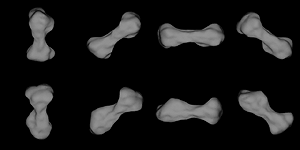
NASA astronomers have collected the first-ever radar images of a "main belt" asteroid, a metallic, dog bone-shaped rock the size of New Jersey, an apparent leftover from an ancient, violent cosmic collision.
The asteroid, named 216 Kleopatra, is a large object in the main asteroid belt between Mars and Jupiter; it measures about 135 miles (217 kilometers) long and about 58 miles (94 kilometers) wide. Kleopatra was discovered in 1880, but until now, its shape was unknown.
"With its dog bone shape, Kleopatra is one of the most unusual asteroids we've seen in the Solar System," said Dr. Steven Ostro of NASA's Jet Propulsion Laboratory, Pasadena, CA, who led a team of astronomers observing Kleopatra with the 1,000-foot (305- meter) telescope of the Arecibo Observatory in Puerto Rico. "Kleopatra could be the remnant of an incredibly violent collision between two asteroids that did not completely shatter and disperse all the fragments."
The astronomers used the telescope to bounce radar signals off Kleopatra. With sophisticated computer-analysis techniques, they decoded the echoes, transformed them into images, and assembled a computer model of the asteroid's shape. The Arecibo telescope underwent major upgrades in the 1990s, which dramatically improved its sensitivity and made it feasible to image more distant objects.
These new radar images were obtained when Kleopatra was about 106 million miles (171 million kilometers) from Earth. Travelling at the speed of light, the transmitted signal took about 19 minutes to make the round trip to Kleopatra and back.
"Getting images of Kleopatra from Arecibo was like using a Los Angeles telescope the size of the human eye's lens to image a car in New York," Ostro said.
Kleopatra is one of several dozen asteroids whose coloring suggests they contain metal. Kleopatra's strong reflection of radar signals indicates it is mostly metal, possibly a nickel-iron alloy. These objects were once heated, melted and differentiated into structures containing a core, mantle and crust, much as the Earth was formed. Unlike Earth, those asteroids cooled and solidified throughout, and many underwent massive collisions that exposed their metallic cores. In some cases, those collisions launched fragments that eventually collided with Earth, becoming iron meteorites like the one that created Meteor Crater in Arizona.
"But we don't need to worry about Kleopatra -- it will never hit Earth," Ostro said.
"The radar-based reconstruction of Kleopatra's shape shows the object's two lobes connected by a handle, forming a shape that resembles a distorted dumbbell, or dog bone," said Dr. R. Scott Hudson of Washington State University, Pullman, WA. "The shape may have been produced by the collision of two objects that had previously been thoroughly fractured and ground into piles of loosely consolidated rubble. Or, Kleopatra may once have been two separate lobes in orbit around each other with empty space between them, with subsequent impacts filling in the area between the lobes with debris."
"The radar observations indicated the surface of Kleopatra is porous and loosely consolidated, much like surface of the Moon, although the composition is different," said Dr. Michael Nolan of the Arecibo Observatory. "Kleopatra's interior arrangement of solid metal fragments and loose metallic rubble, and the geometry of fractures within any solid components, are unknown. What is clear is that this object's collision history is extremely unusual."
"It is amazing that nature has produced a giant metallic object with such a peculiar shape," said Ostro. "We can think of some possible scenarios, but at this point none is very satisfying. The object's existence is a perplexing mystery that tells us how far we have to go to understand more about asteroid shapes and collisions."
The team's findings will appear in the May 5 issue of the journal Science. Ostro's team includes Hudson; Nolan and Jean-Luc Margot of the Arecibo Observatory; Dr. Daniel Scheeres of the University of Michigan, Ann Arbor; Dr. Donald Campbell of Cornell University, Ithaca, N.Y; Dr. Christopher Magri of the University of Maine at Farmington; and Jon Giorgini and Dr. Donald Yeomans of the Jet Propulsion Laboratory.
The Kleopatra images (and an animation) are available at: http://www.jpl.nasa.gov/pictures/kleopatra
The Arecibo Observatory is part of the National Astronomy and Ionosphere Center, operated by Cornell University for the National Science Foundation. The Kleopatra radar observations were supported by NASA's Office of Space Science, Washington, DC. JPL is managed for NASA by the California Institute of Technology in Pasadena.
Donald Savage
Headquarters, Washington, DC
(Phone: 202/358-1547)
Jane Platt
Jet Propulsion Laboratory, Pasadena, CA
(Phone: 818/354-0880)
RELEASE: 00-74
 Asteroid Home Page
- NSSDCA
Asteroid Home Page
- NSSDCA Asteroid Fact Sheet
- NSSDCA
Asteroid Fact Sheet
- NSSDCA
 Planetary News Page
Planetary News Page
 NSSDCA Planetary Home Page
NSSDCA Planetary Home Page